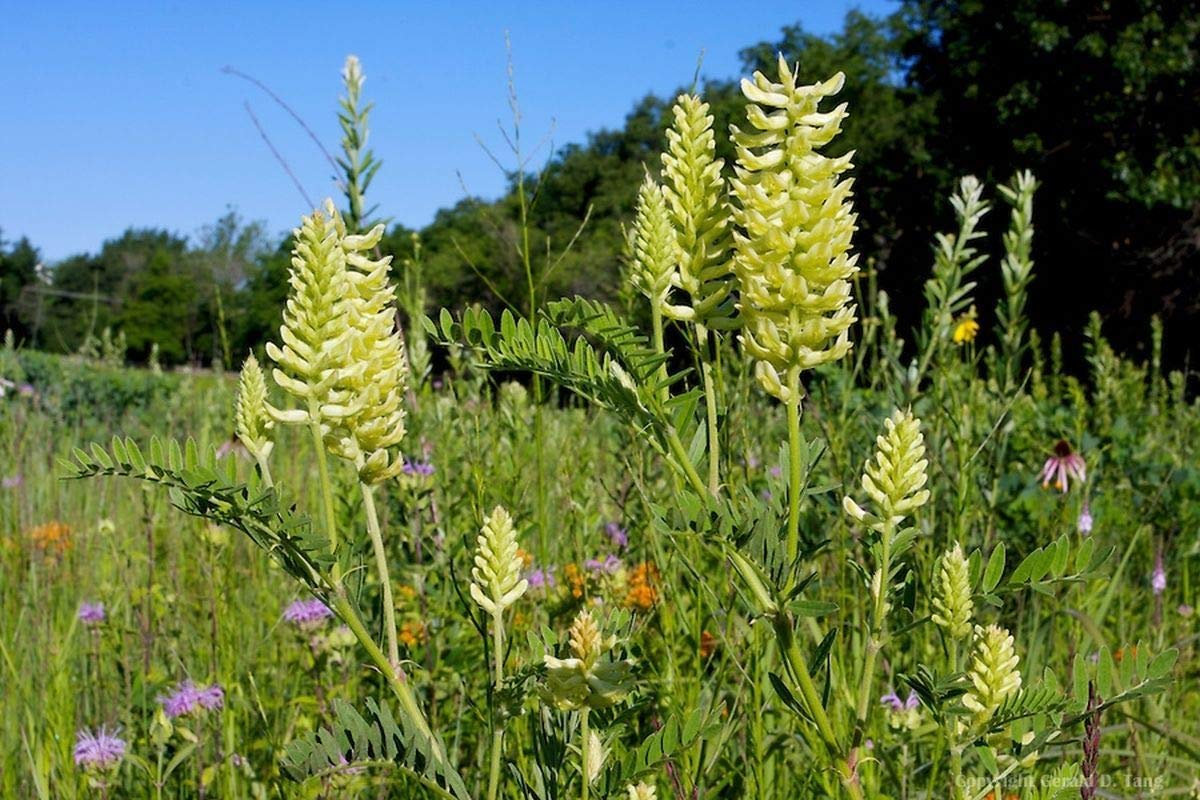
Dharaseeds
Astragalus racemosus Creamy Milk Vetch
Estimated Free Delivery between April 16 and April 19.
Secured Payment Methods
Your transaction is protected with advanced security measures to keep your information confidential
Astragalus racemosus, commonly known as Creamy Milk Vetch, is a perennial herbaceous plant belonging to the pea family (Fabaceae). Native to the prairies and grasslands of North America, it is celebrated for its delicate appearance and its role in soil enrichment. Like other species of Astragalus, this plant is a nitrogen-fixer, improving soil fertility while adding beauty to your garden with its creamy, light-colored flowers.
Key Benefits
- Soil Enrichment: As a legume, Astragalus racemosus fixes nitrogen in the soil, improving its fertility for surrounding plants.
- Drought Tolerance: It thrives in dry conditions, making it an excellent choice for xeriscaping or drought-resistant gardens.
- Pollinator Attraction: The plant's attractive flowers draw bees, butterflies, and other pollinators, promoting biodiversity.
- Wildlife Support: Provides food and habitat for wildlife, including small mammals and birds that feed on its seeds and foliage.
- Medicinal Uses: Like other members of the Astragalus genus, it has been traditionally used in herbal medicine to boost the immune system and promote general health.
Variety Features
- Plant Characteristics: Astragalus racemosus has feathery, lance-shaped leaves and produces clusters of creamy white to pale yellow flowers that resemble pea flowers. These flowers typically bloom in late spring or early summer.
- Height: Grows to approximately 18–24 inches (45–60 cm) tall.
- Flower Color: The flowers are creamy white to pale yellow, arranged in racemose clusters.
- Growth Habit: The plant has a bushy, clumping growth habit with a taproot system that helps it survive in dry and poor soils.
- Foliage: The foliage consists of pinnate leaves with several pairs of small, oval leaflets that add to the plant's delicate appearance.
Planting Instructions
Planting Season
- Best Time to Plant: Plant in early spring or fall when the soil is moist, and temperatures are mild.
- Temperature: Prefers moderate temperatures, ideally between 60°F to 75°F (15°C to 24°C).
Planting Details
- Planting Depth: Sow seeds about 1/4 inch deep in the soil.
- Spacing: Space plants 12–18 inches apart to allow for their spread and adequate air circulation.
- Soil Requirements: Prefers well-drained, sandy, or loamy soils. While it thrives in moderately fertile soils, it can grow in less fertile, dry conditions due to its nitrogen-fixing capabilities.
- Sunlight: Full sun to partial shade is ideal. However, the plant will do best in full sun.
- Watering: Water deeply after planting, but avoid over-watering. Once established, Astragalus racemosus is drought-tolerant and does not require regular watering.
Care Instructions
- Watering: Water deeply but infrequently to encourage deep root growth. The plant is drought-tolerant once established and requires minimal watering.
- Fertilization: No fertilization is necessary, as the plant improves soil fertility through nitrogen fixation. Excessive fertilizer can harm its ability to fix nitrogen and may stunt growth.
- Pruning: Prune dead or damaged stems to encourage healthy growth and maintain the plant's appearance.
- Pest and Disease Control: Astragalus racemosus is generally pest-resistant. However, keep an eye out for aphids or mildew in moist, humid conditions.
- Winter Care: This plant is hardy in most temperate climates. It can tolerate cold winters and will die back to the ground, regenerating in the spring.
Harvesting
- Seeds: Harvest seed pods when they are dry and brittle. Open the pods to collect the seeds for replanting or use.
- Medicinal Use: If you are interested in using it for medicinal purposes, consult an expert on the proper preparation methods, as some Astragalus species can have toxic effects if improperly processed.
Storage
- Seed Storage: Store collected seeds in a cool, dry place in an airtight container. Seeds should remain viable for up to 3 years if stored properly.
- Medicinal Use: Dried plant material should be kept in a dark, dry location in an airtight container to preserve its medicinal properties.
Culinary and Medicinal Uses
- Culinary Uses: While Astragalus racemosus is not commonly used in culinary dishes, other species in the Astragalus genus are used in traditional recipes, particularly in teas and herbal soups. Consult with an expert before considering it for consumption.
- Medicinal Uses: Traditionally, Astragalus species, including Astragalus racemosus, are used for their purported immune-boosting properties. They are often consumed in the form of teas, tinctures, or capsules. Astragalus is known for its adaptogenic properties, helping the body cope with stress and improving overall vitality. However, it's essential to seek guidance from a healthcare professional before using this herb medicinally.
Conclusion
Astragalus racemosus, or Creamy Milk Vetch, is a hardy, beneficial plant for the garden, especially for gardeners looking to improve soil quality and support pollinators. Its drought resistance, nitrogen-fixing ability, and beautiful creamy flowers make it an attractive addition to prairie gardens, wildflower meadows, and native plant landscapes. With minimal care, this plant can thrive in various conditions while supporting a healthy garden ecosystem. Whether used for its aesthetic appeal or its potential medicinal properties, Creamy Milk Vetch is a valuable and sustainable choice for gardeners and herbalists alike.









